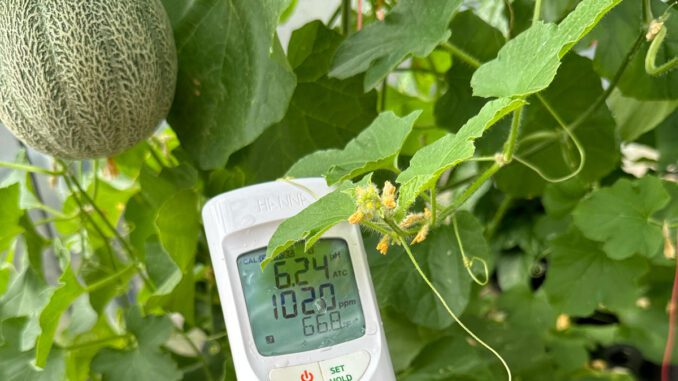
How To Grow Hydroponic Melons
Growing hydroponic melons is an excellent choice for hydroponic crop cultivation. Most melon varieties, i.e. Cantaloupe, Watermelon and Honeydew cultivars will thrive in hydroponic gardens when given enough space, healthy air, light and good nutrition. Melons love water, so water culture systems like DWC (deep water culture) and RDWC (recirculating deep water culture) are an especially good choice when growing hydroponic melons.
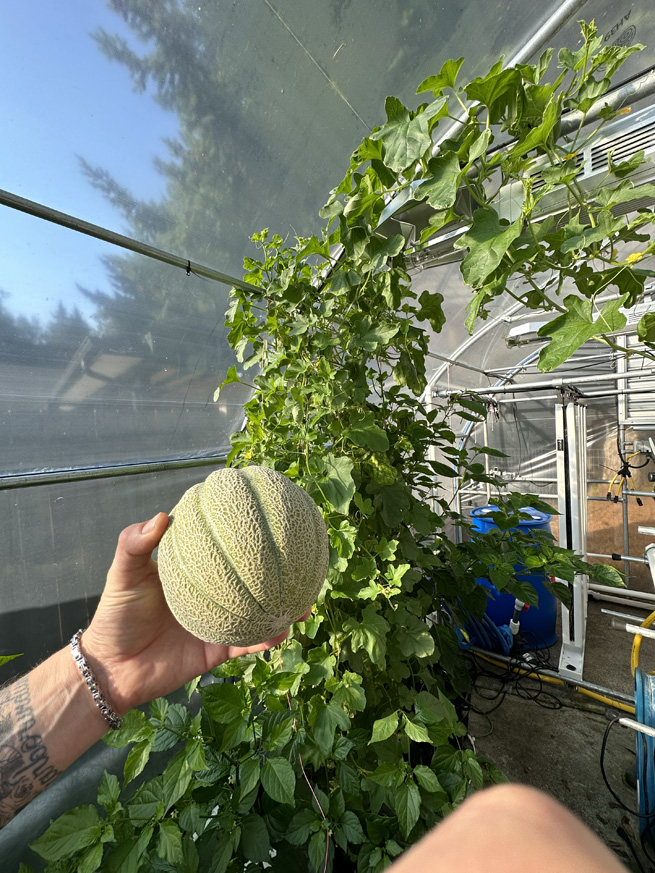
Production can be prolific and hydroponic melons are firm, juicy and sweet as candy when vine ripened. The difference versus grocery store bought is akin to a homegrown garden tomato versus store bought in the winter time. In fact, people who claimed to not especially like melons often change their mind after sampling a vine ripened hydroponic melon; really, they are that good!
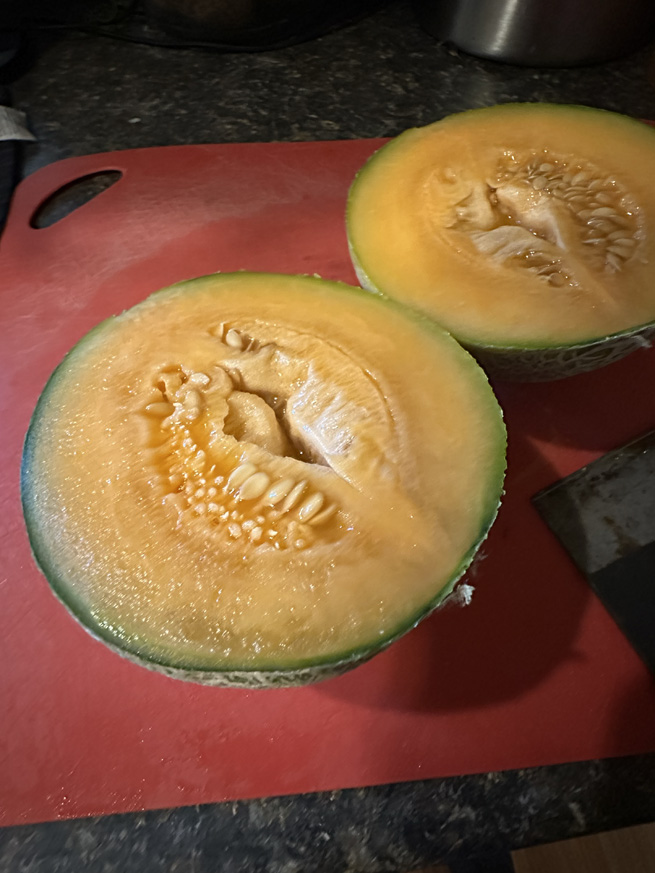
Cultivar Selection
When it comes to growing hydroponic melons, we are fans of harvesting individual sized melons–ie mini melons are perfect for an individual feast, snacking amongst a few friends or even halved for tasty fruit based dessert bowls. This way there is less waste, no need to take up valuable fridge space and the melons are enjoyed at peak freshness.
In our trial for growing hydroponic melons we selected an heirloom variety of cantaloupe called “Minnesota Midget”. It’s been around for a very long time and seeds are easy to get—we can highly recommend it based on production, hardiness and taste too.
Other great choices for growing hydroponic melons include:
Hearts of Gold (Medium sized Cantaloupe)
Sarah’s Choice (Medium sized Cantaloupe)
Sugar Baby (Mini sized Watermelon)
Tam Dew (Small to Medium Honeydew)
Earli Dew (Small to Medium Honeydew)
Most melons will take from 70 to 90 days from sowing seeds to maturity when grown with hydroponics in a warm climate. One of the benefits of water culture systems is that with a small aquarium heater in your growth module that contains the nutrient solution you can extend the growing season, whether starting earlier or going later (or both). Plants will tolerate cooler air temperatures as long as rootzone temperatures remain optimal–this is much more economical than trying to heat large volumes of air for the shoots.
Starting Hydroponic Melons
Once you have your seeds on hand, you can begin the germination process to get started on growing hydroponic melons. You won’t need much space for the first four weeks—simple nursery flats or hydroponic propagation systems should be ample with some supplemental lighting (LED or Fluorescent light strips).
Make sure you can maintain a steady warm environmental temperature, with around 21 deg C being optimal in most instances. A heating mat with a thermostat for trays or an aquarium heater in water culture systems are good ways to maintain optimal temperatures while keeping power bills reasonable.
A soilless germination medium is recommended, ie clean, sterile and not prone to water logging. iHort Plugs, Oasis cubes or rockwool plugs are good choices. Peat pellets may also be used, but these tend to stay too wet once transplanted to hydroponics and could promote stem rot or other issues.
Pre-treat your growing medium or prepare your water culture system with lighting before planting seeds—check the environment can be maintained at optimal. Steady even temperatures are best for germinating most seeds. A good temperature range for germination is 72 to 78 deg F, some varieties will respond better to warmer temperatures.
One or two strips of fluorescent or LED full spectrum or horticultural lighting helps to keep the air warm and stimulates strong young plants–lights should be around 12 inches from the top of the growth medium. Eighteen hours of lights ON and six hours of lights OFF is a good photoperiod for germination and establishing young plants. 150uMol-s of PPFD is a good light level for young light loving plants if you are using a light meter.
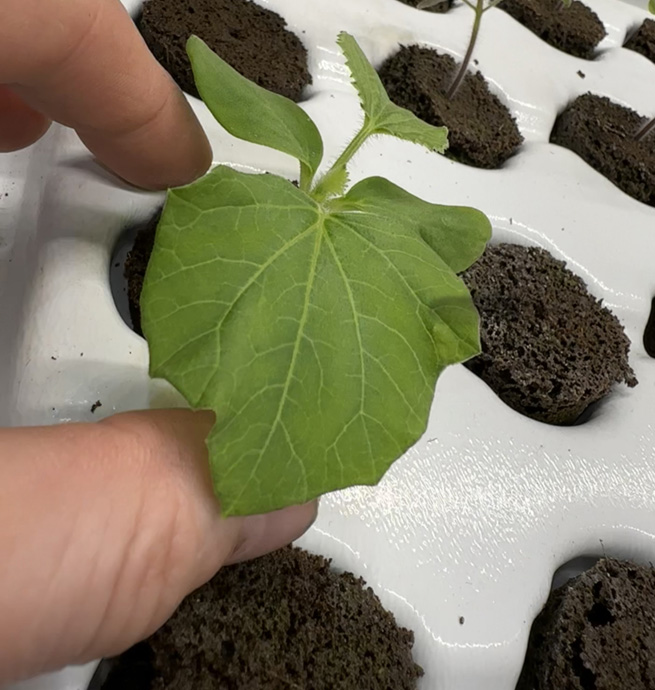
If using humidity domes on trays, remove the domes once 50% of the seeds have emerged (don’t worry the rest should follow; even without the dome). This helps keep seedlings sturdy, healthy and reduces the chances of propagation diseases like stem rot or root rot.
After the first set of true leaves emerge you can feed with a complete hydroponic fertilizer at around 0.2 to 0.3 EC and a pH range of 5.8 to 6.3.
Try and keep the air humidity from 65 to 75% RH, drier will stress young plants. An occasional misting of fresh, clean water can help.
Hydroponic Melons, Systems & Environmental Requirements
Once your seedlings are well established, usually after three to five weeks, they can be transplanted into your RDWC or DWC hydroponic system.
The nutrient solution temperature should be from 67 to 75 deg F, although warmer is usually OK if maintaining “clean” nutrient solutions. Good aeration of the nutrient solution is key for success and fast lush plants in DWC and RDWC growing hydroponic melons.
Growing hydroponic melons in the greenhouse, a warmer air temperature range of 75 to 85 deg F gives excellent results and yields healthy plants. Once well established, hydroponic melon plants will tolerate drier air to a point, but prefer to be in the 60 to 70% RH range.
Relative humidity becomes especially important once hydroponic melons start to flower. Flowers will drop off or not pollinate if the air is excessively dry or humid. Extra calcium supplied to plants when flowering strongly helps. Remember, no pollination means no fruits! Gently shaking plants can help, especially with gentle air movement—bees are definitely your friend!
Growing hydroponic melons in full sun or strong grow lighting is advised for best production, for example 900 to 1800 uMol-s after plants are well establsihed. Sometimes large and lush melon foliage will wither a bit in the hottest part of the day–don’t panic and do anything drastic. Often, you’ll find they return to normal over the course of the evening or dark cycle.
Feeding established hydroponic melons with a full spectrum hydroponic Bloom formula is recommended; typically you can follow a reputable manufacturers’ feeding chart with success, but you’ll do just great with a simple complete bloom fertilizer. Remember, they are growing and flowering at the same time. Under heavy fruit load, consider adding a high potassium Bud or Bloom booster.
Maintain an EC of 1.2 to 1.5 and pH of 5.8 to 6.4 in your RDWC or DWC hydroponic system. Weekly additions of hypochlorous acid helps keep roots clean and hygienic, especially in warmer conditions.
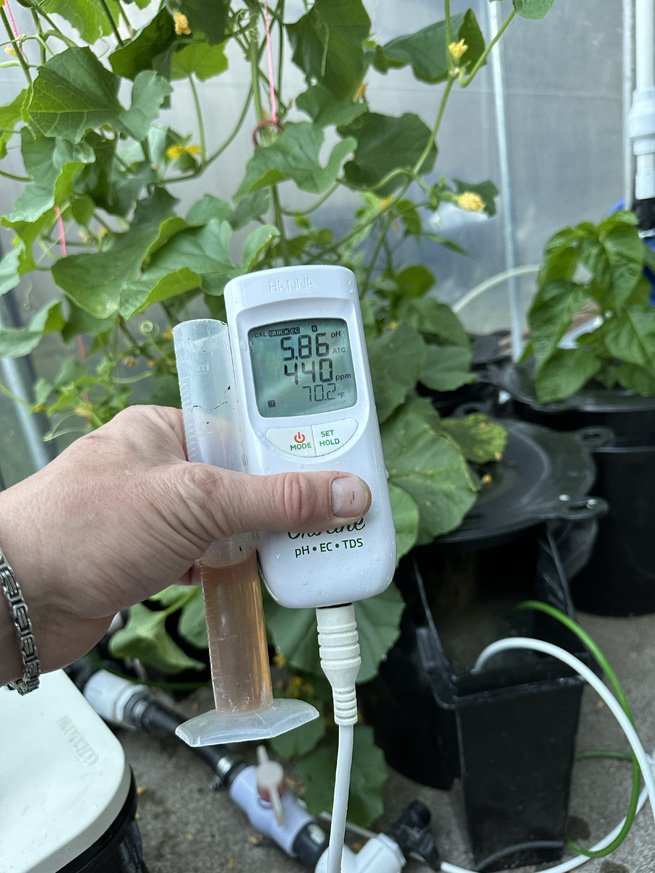
Cultural Practices
When growing hydroponic melons, trellising will be required, unless you want to train plants to grow on the ground. Keeping the fruits up and off potentially contaminated surfaces keeps your food hygienic and produces and abundance of fruits. Tomato clips and twine work great; using netting is an option too (although it poses a danger to wildlife outdoors or in landfills).
Its’a amazing to see how a well trellised hydroponic melon vine can support the weight of many heavy fruits–they stay very attached to the vines until fully ripened. Some growers will support individual fruits with netting or even old bras (great for watermelons), although we didn’t find it was necessary growing “personal sized” cantaloupe cultivars.
Watch for the usual pests and diseases, like powdery mildew, downy mildew, fire blight, spider mites, moths, caterpillars, etc. We encountered no problems growing hydroponic melons in the greenhouse, heirloom varieties are especially good at resisting problems, seemingly. Yellow sticky traps are a good way to monitor any potential insect pressures.
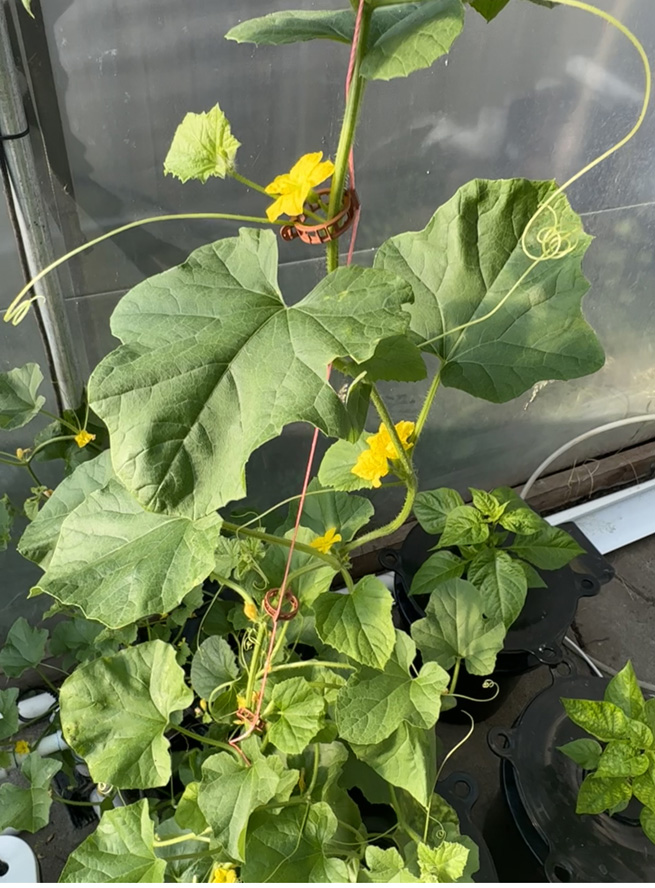
When to Harvest Hydroponic Melons
The original flower usually remains attached to the fruit (look on bottom) that has developed. When this falls off on it’s own or pulls off easily is a good sign of ripening.
In the case of cantaloupes, they develop a very distinct webbing or netting to the fruit as they mature. They start off as very dark green and look almost pale to yellow when mature.
When near peak maturity, the melons give off a sweet melon smell; you have to get pretty close to detect this typically. That’s right, stick your face right up to those melons.
Ripe melons will break free of the vine with just a gentle tug; you shouldn’t need to pull very hard at all for a properly ripened melon. Also look on the ground a couple times a day–they can just randomly drop off the plant if fully ripened. In the case of cantaloupes, their skin is firm, and no damage occurred to the inner fruit if “fall down ripened”.

Enjoy your harvest! You’ll likely find you have an abundance for gifting or swapping with friends. Hydroponic melons can be eaten fresh, cleaned and frozen for smoothies and even juiced. You’ll also find that hydroponically grown melon can keep a long time in the fridge versus store bought.
Prosciutto wrapped cantaloupe slices is a timeless classic when entertaining; that combination of salty and sweet!
